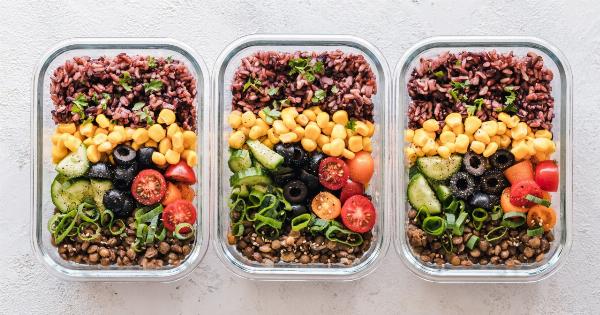Honey and sugar are two common sweeteners used widely in cooking and baking. They both add sweetness to our favorite dishes and treats, but they differ in various ways, including their taste, nutritional composition, and production process.
In this article, we will explore the differences between honey and sugar to help you make informed choices when it comes to sweetening your foods.
Taste
One of the primary differences between honey and sugar is their taste. Honey offers a distinct, rich, and complex flavor profile. The taste of honey can vary depending on the flower nectar collected by bees.
For instance, clover honey has a mild and delicate flavor, while buckwheat honey has a more robust and earthy taste. Sugar, on the other hand, is pure sucrose and has a simple, sweet taste.
Nutritional Composition
When it comes to nutritional composition, honey and sugar also differ significantly. Honey is a natural sweetener that contains trace amounts of vitamins, minerals, antioxidants, and enzymes.
These components are usually present in amounts too small to have a substantial impact on your overall nutrient intake. On the contrary, sugar provides empty calories without any significant nutritional value.
Honey contains small amounts of minerals like potassium, calcium, and magnesium, as well as vitamins like vitamin C and certain B vitamins. It also contains antioxidants, such as flavonoids, which have been linked to various health benefits.
However, it’s important to note that the nutritional content of honey varies depending on its source and processing.
Sugar, specifically refined white sugar, offers no significant nutritional benefits. It is essentially “empty calories” that add sweetness but lack vitamins, minerals, or antioxidants.
Glycemic Index
The glycemic index (GI) is a measure of how quickly carbohydrates in a food raise blood sugar levels. Foods with a high GI, like sugar, cause a rapid spike in blood sugar, leading to a subsequent crash and potential energy slumps.
On the other hand, honey has a lower glycemic index compared to sugar, which means it raises blood sugar levels more gradually.
The lower glycemic index of honey can be attributed to various factors, such as its fructose content and the presence of certain enzymes.
However, it’s worth noting that the glycemic index can still vary depending on the type and processing of honey.
Absorption and Metabolism
When consumed, both honey and sugar are broken down into glucose and fructose molecules by enzymes in our bodies. However, honey contains certain enzymes that aid digestion and metabolism.
These enzymes, such as amylase and invertase, help break down complex carbohydrates, making honey easier to digest compared to sugar.
Moreover, due to its slightly acidic pH, honey also helps slow down the digestion of starches, which can be beneficial for individuals watching their blood sugar levels.
Caloric Content
In terms of calorie content, honey and sugar are relatively similar. Honey is denser and slightly higher in calories, containing about 64 calories per tablespoon. Sugar, on the other hand, has around 49 calories per tablespoon.
While the difference may seem small, it can add up over time if you consume large amounts of sweeteners.
Antibacterial Properties
Honey has been used for its medicinal properties for centuries. It possesses natural antimicrobial and antibacterial properties due to the presence of hydrogen peroxide, bee defensin-1, and certain acidic pH levels.
These properties make honey effective in wound healing and preventing bacterial infections when applied topically.
On the contrary, sugar lacks such antibacterial properties and cannot be used as a substitute for honey when it comes to topical applications.
Production Process
The production processes of honey and sugar also greatly differ. Honey is a natural product made by bees from flower nectar. Bees collect the nectar, process it with enzymes in their bodies, and store it in honeycombs.
The excess moisture is then evaporated, resulting in thick, sweet honey.
Sugar, on the other hand, undergoes an extensive refining process. It is usually extracted from sugarcane or sugar beets, then processed and purified to obtain white, granulated sugar.
This refining process removes molasses and other impurities, resulting in a pure sucrose product.
Forms and Versatility
Honey and sugar offer different forms and versatility in their usage. Honey is typically available in liquid form, but it can also crystallize over time. The consistency and taste of honey can vary depending on its floral source and processing methods.
Honey is commonly used as a natural sweetener in beverages, baked goods, dressings, and marinades.
Sugar, on the other hand, comes in various forms, including granulated white sugar, brown sugar, powdered sugar, and more. Each type of sugar has its distinct characteristics and ideal applications.
Sugar is highly versatile and widely used in baking, cooking, and sweetening beverages.
Final Thoughts
In conclusion, honey and sugar differ in terms of taste, nutritional composition, glycemic index, absorption and metabolism, caloric content, antibacterial properties, production process, forms, and versatility.
Honey offers a more complex flavor profile, contains trace amounts of nutrients and antioxidants, has a lower glycemic index, aids in digestion, and possesses antibacterial properties. Sugar, on the other hand, provides simple sweetness without any significant nutritional value.
Ultimately, whether you choose honey or sugar depends on your personal preferences, dietary needs, and health considerations. It’s essential to consume both sweeteners in moderation to maintain a balanced diet.






























